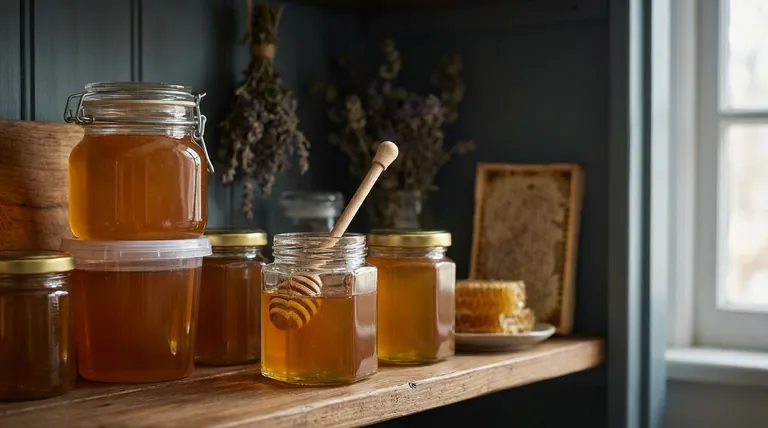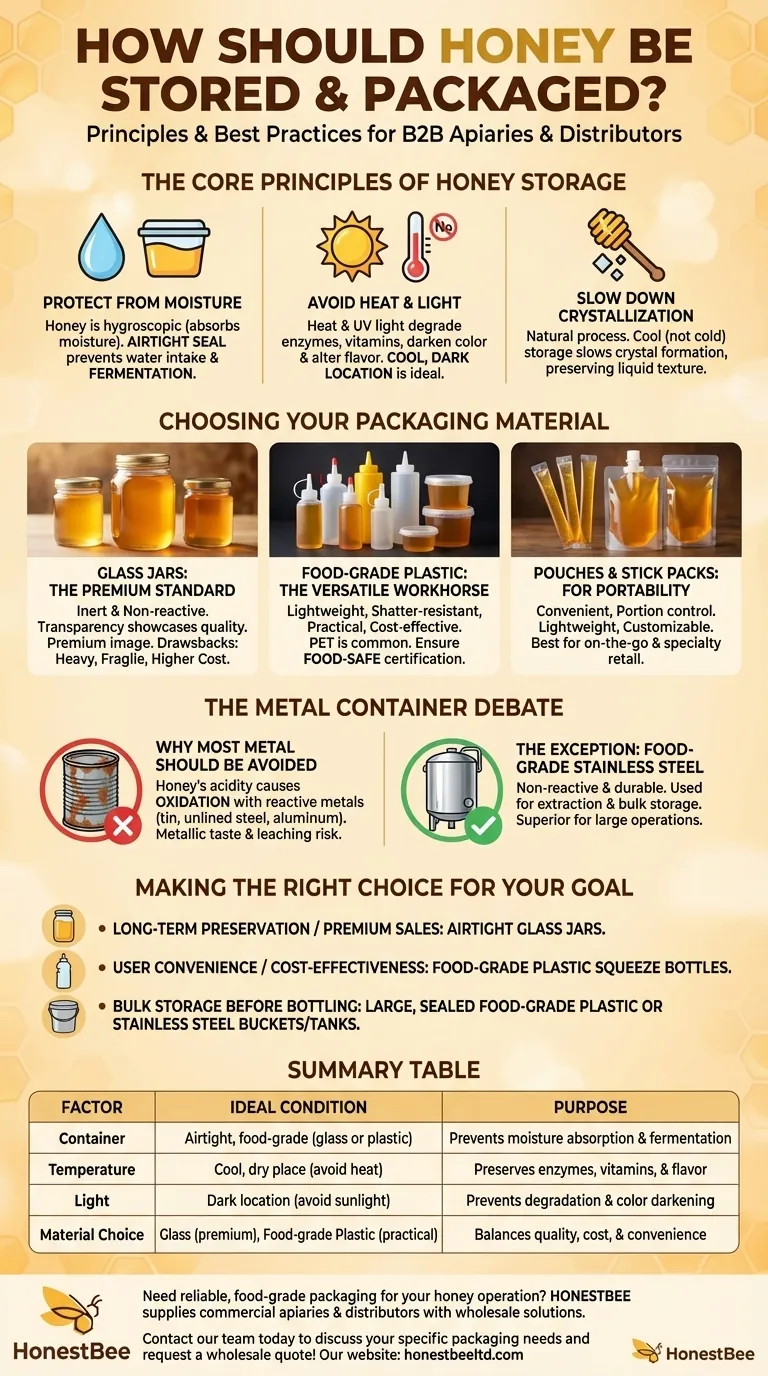To properly store and package honey, you must place it in an airtight, food-grade container and keep it in a cool, dry, and dark location. The best consumer-facing materials are glass jars or specific food-safe plastics, as they protect the honey from its two main enemies: air moisture and heat. Avoiding direct sunlight and ensuring the lid is tightly sealed is critical to prevent fermentation and degradation.
Storing honey is not just about preventing spoilage; it's about preserving its unique flavor, texture, and beneficial properties. The right container and environment act as a shield against moisture, light, and heat, which can otherwise lead to fermentation, nutrient loss, and unwanted crystallization.
The Core Principles of Honey Storage
Proper storage is a simple science. Honey's longevity depends on controlling three environmental factors: moisture, heat, and light.
Protect from Moisture
Honey is hygroscopic, meaning it naturally absorbs moisture from the atmosphere. If the container is not airtight, the honey will draw in water, increasing its water content.
This excess water can activate dormant yeasts present in the honey, leading to fermentation. An airtight seal is your primary defense against this.
Avoid Heat and Light
Storing honey in a warm place or in direct sunlight will degrade its quality. Heat and UV light can destroy sensitive enzymes and vitamins.
These elements also darken the honey's color and can subtly alter its flavor profile over time. A cool, dark pantry or cupboard is the ideal environment.
Slow Down Crystallization
Crystallization is a natural process where glucose separates from the water in honey, forming crystals. It is not a sign of spoilage.
However, storing honey in a cool (but not cold) location helps slow this process significantly, preserving the smooth, liquid texture most people prefer.
Choosing Your Packaging Material
The container you choose affects everything from shelf life and consumer perception to user convenience.
Glass Jars: The Premium Standard
Glass is the gold standard for honey packaging. It is completely inert, meaning it will not react with the honey or leach any chemicals.
Its transparency allows customers to see the quality of the product, and it conveys a premium, high-quality image. The main drawbacks are its weight, higher cost, and fragility.
Food-Grade Plastic: The Versatile Workhorse
Food-grade plastic containers, especially PET (polyethylene terephthalate), are a popular, cost-effective choice. They are lightweight, shatter-resistant, and can be formed into user-friendly squeeze bottles.
This makes them highly practical for everyday use and reduces shipping costs. Ensure any plastic you use is certified as food-safe to avoid any potential chemical contamination.
Pouches and Stick Packs: For Portability
Single-serving pouches, tubes, and stick packs are excellent for on-the-go applications. They offer convenience and portion control for consumers.
This type of packaging is lightweight and customizable but is primarily used for commercial food service or specialty retail products rather than bulk home storage.
Understanding the Trade-offs: The Metal Container Debate
While certain metals are used in honey processing, they are generally not recommended for consumer packaging or long-term storage due to a significant risk.
Why Most Metal Should Be Avoided
Honey is slightly acidic. When stored in containers made of reactive metals like tin, unlined steel, or aluminum, this acidity can cause oxidation.
This reaction can impart a metallic taste to the honey and may leach harmful compounds into the product, compromising its quality and safety.
The Exception: Food-Grade Stainless Steel
The exception to the "no metal" rule is food-grade stainless steel. Large beekeeping operations use stainless steel tanks for extraction, filtering, and bulk storage because it is non-reactive and durable.
However, for final consumer packaging, glass and food-grade plastic remain the superior and more common choices.
Making the Right Choice for Your Goal
Your packaging decision should align directly with your intended use, whether you're a hobbyist beekeeper or a commercial producer.
- If your primary focus is long-term preservation or premium sales: Airtight glass jars are the best choice to protect quality and enhance perceived value.
- If your primary focus is user convenience and cost-effectiveness: Food-grade plastic, especially in the form of squeeze bottles, offers the best balance of utility and price.
- If your primary focus is bulk storage before bottling: Use large, sealed buckets made of food-grade plastic or stainless steel.
By choosing the right container, you ensure the honey remains as pure and flavorful as the day it was harvested.

Summary Table:
| Factor | Ideal Condition | Purpose |
|---|---|---|
| Container | Airtight, food-grade (glass or plastic) | Prevents moisture absorption and fermentation |
| Temperature | Cool, dry place (avoid heat) | Preserves enzymes, vitamins, and flavor |
| Light | Dark location (avoid sunlight) | Prevents degradation and color darkening |
| Material Choice | Glass (premium), Food-grade Plastic (practical) | Balances quality, cost, and convenience |
Need reliable, food-grade packaging for your honey operation? HONESTBEE supplies commercial apiaries and beekeeping equipment distributors with high-quality, wholesale packaging solutions designed to protect your product's integrity. From durable plastic buckets for bulk storage to premium glass jars for retail, we provide the equipment you need to ensure your honey reaches the market in perfect condition. Contact our team today to discuss your specific packaging needs and request a wholesale quote!
Visual Guide

Related Products
- Hexagonal Glass Honey Jars with Metal Lug Caps Elegant Versatile Packaging
- Squeezable No-Drip Beehive-Shaped Honey Jars with Flip-Top Cap
- Inverted Squeezable Honey Jar with No Drip Flip Top Cap for Easy Pouring
- Classic Drum Shaped Glass Honey Jar with Airtight Lid
- Classic Honey Bear Jars with Flip Top Dispensing Cap for Liquid Sweeteners
People Also Ask
- What is done with the honey after extraction and filtering? From Purification to Perfect Packaging
- What are the advantages of using glass jars for honey packaging? Preserve Purity & Elevate Your Brand
- What is the best way to jar honey? Preserve Quality with the Right Container
- What makes raw honey more aesthetically appealing than processed honey? Discover the Beauty of Authenticity
- How many jars of honey do you get from a hive? Unlock Sustainable Harvesting Secrets



















